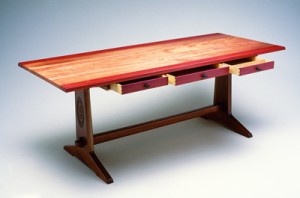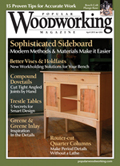We may receive a commission when you use our affiliate links. However, this does not impact our recommendations.
 Choose your own styles and techniques: simple, advanced, or somewhere in-between.
Choose your own styles and techniques: simple, advanced, or somewhere in-between.
By Graham Blackburn
Pages 50-53
In furniture, the term “trestle” historically referred to a pair of diverging legs wide enough to be self-supporting, and joined at their upper end, sometimes by hinges. Two or more such trestles that support a wide board form a table, which can be easily folded up and moved.
The trestle table has a long history. Six hundred years ago in Europe, when only the rich had valuable furniture and carried it around with them from one castle to the next, portability was of prime importance. Large and relatively immobile tables would have been out of the question. Times may be more secure now, but given the rate at which many people change addresses, an easily disassembled and transported table remains an idea whose day is far from over.
Today, however, the term “trestle table” usually implies something more sophisticated than the original design, and most commonly describes a table that is supported not by a pair of trestles, nor by the usual arrangement of four corner legs, but by two pieces connected by a horizontal beam or stretcher, often secured in place by wedged mortises. That base assembly supports the actual tabletop.
In this article I discuss two different trestle table designs – one small and very basic; the other large and more advanced. The first could serve well as a side or entry table. The larger would make a fitting dining table or, if outfitted with drawers, a desk. As you design and build your own, feel free to mix and match the two to design a table that suits your needs.
The trestle table form is adaptable for tables from small to large. All that is really necessary are two uprights, a stretcher and a tabletop. The uprights must, of course, be tall enough to support the tabletop at the required height, broad enough at the base to provide sufficient stability for the size desired and wide enough at the top to provide adequate connection for the tabletop.
If you wish to preserve the knock-down function of a true trestle table, the stretcher connecting the two supports should be removable, but fixed stretchers such as described in this first example are by no means uncommon.
Build From the Top Down
This top can be made from a single board or from several pieces glued together with edge joints. The gently curved ends of the top shown above at right echo the curved shape of the foot part of the uprights. Because the material used for this table is 11⁄4″ thick, the lower edge of the top has been beveled to leave a 3⁄4″-thick face all around in order to lighten the look.
Video: See a free preview and purchase issues of Graham Blackburn’s video magazine, “Woodworking in Action.”
Article: Christopher Schwarz builds an American Trestle Table.
To Buy: Download step-by-step instructions for an American trestle table.
From the April 2013 issue #203
Buy this issue now

Here are some supplies and tools we find essential in our everyday work around the shop. We may receive a commission from sales referred by our links; however, we have carefully selected these products for their usefulness and quality.







